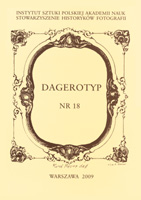Awit Szubert, krakowski fotograf drugiej połowy XIX wieku
Awit Szubert, a photographer from Cracow living in the second half of the 19th century
Author(s): Katarzyna KudłaczSubject(s): Photography
Published by: Instytut Sztuki Polskiej Akademii Nauk
Keywords: photography; Polish photography; vintage photography; history of photography; old photographic technique; Subert; Awit; Cracow; wet collodion process; platinotype; photoceramic; autochrome; colour photogtaphy; mountain photogtaphy
Summary/Abstract: The article is a short study on Szubert (1837-1919), one of the most important Polish photographers of the 19th century. Szubert’s first studio, in Oświęcim (1864-1866), was fairly small. In the years 1871-1875, he erected in Cracow a brick building in stages, with the reception area and negative archive occupying the second row of rooms on the ground floor of the tenement building, and a glazed atelier, which was added later. After the First World War, the premises were not used in accordance with their intended purpose; in 1931 a fire broke out, destroying the entire negative archive that had survived from the studio, and in the 1990s, the rest of the building was demolished. Also the studio in Szczawnica, located within a wooden spa casino, burned down in a fire in the 1960s. All that remains of both studios is the photographs themselves. Szubert was also a good commercial photographer, producing all kinds of portraits and in formats that were fashionable at the time, often colouring them in by hand. He would only use glass plates, initially using the wet collodion process, from 1878 using factory-made silver gelatine dry plates and camera shutters in his workshop, making platinotypes and photoceramics (from 1892), and from around 1910 – Autochrome Lumière. The author has analysed Szubert’s portrait photographs, both in terms of the framing (the backgrounds, furniture and props used) and the composition, as well as the use of light. She has also determined what kind of pictures of Cracow he used to take (including a general view dating from 1878), as well as the painters whose paintings he would produce reproductions of (mostly for Jan Matejko), as well as the fact that he used to collaborate with Cracow historians and archaeologists, as well as one physician. She subsequently focused on Szubert’s mountain pictures, those that he was the best known for. She reconstructed his earliest trips to the Tatra Mountains (which he began probably in 1871) and characterised the photographs, leaving the complicated questions of dating, organising the content and order of the albums (originally compiled from original photographs, from 1889 with photogravures) to future researchers. She also described the photographs from the Pieniny Mountains (from 1865) and from the Wieliczka salt mine, where Szubert took 20 photographs in 1892, 15 of which were compiled into an album of photogravures. Apart from his popularity among his clients and mountain lovers, Szubert also enjoyed a certain international recognition. He won awards at the World Exhibitions held in Vienna in 1873 and in Paris in 1878, as well as at photographic exhibitions in Vienna and Brussels in 1875.
Journal: Dagerotyp
- Issue Year: 2009
- Issue No: 18
- Page Range: 5-79
- Page Count: 71
- Language: Polish
- Content File-PDF

